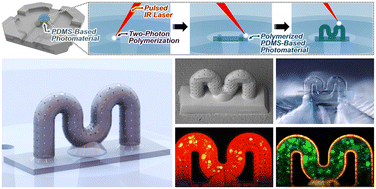Microvessels (e.g., capillaries) are ubiquitous throughout human anatomy, yet recreating their three-dimensional (3D) microfluidic and architectural sophistication at biologically accurate length scales has remained a critical challenge. To overcome this barrier, here we report a hybrid additive manufacturing—or “3D printing”—strategy in which “Two-Photon Direct Laser Writing (DLW)” is used to nanoprint microvessels of arbitrary design directly atop “Liquid-Crystal Display (LCD)” 3D-printed microfluidic chips. Fabrication results indicated effective production of 100 μm-diameter 3D polydimethylsiloxane (PDMS) microfluidic vessels with 5 μm-thick walls—featuring arrays of pre-designed 5 μm-diameter micropores—as well as three discrete spiralled, intertwined microvessels. Experimental results with MDA-MB-231 epithelial breast cancer cells revealed the ability for the 3D PDMS microvessels to support cell culture. In combination, these results suggest that the presented strategy for 3D nanoprinting PDMS microvessels with custom-designed architectures and microporosity offers a promising pathway to enable new classes of “organ-on-a-chip (OOC)” systems for wide-ranging biomedical applications.
